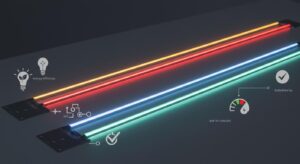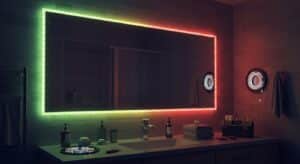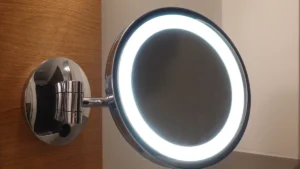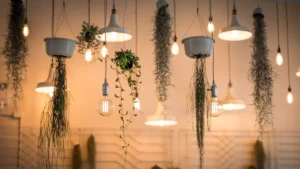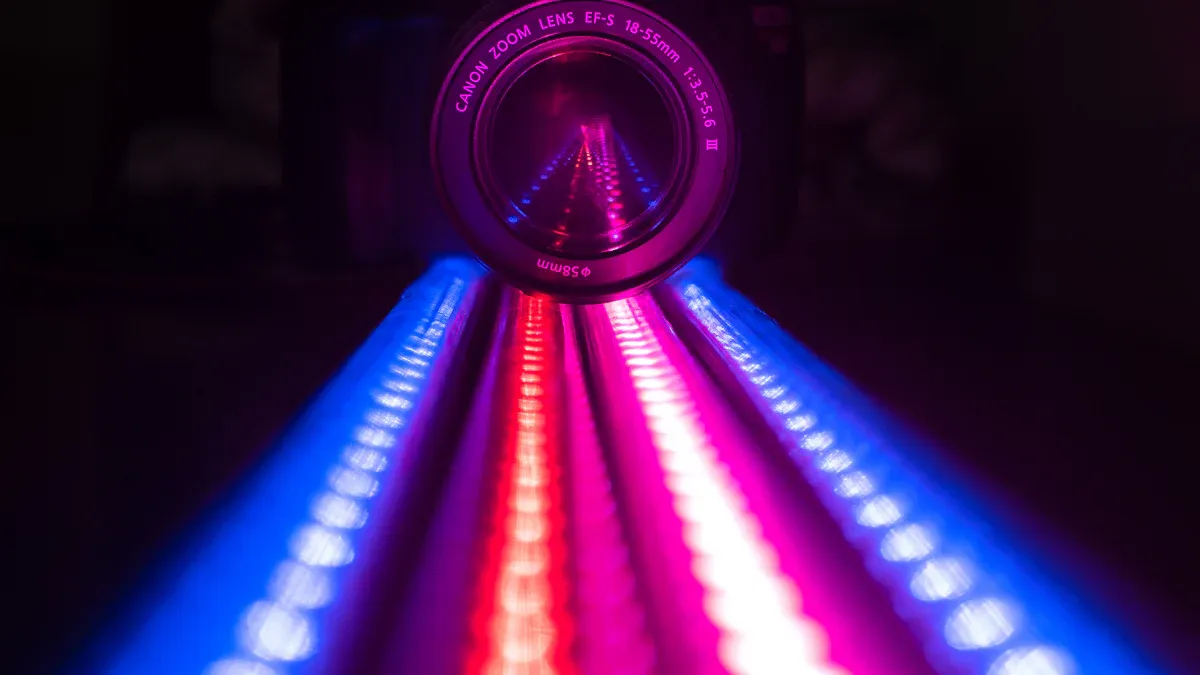
Choosing the right 12V LED strip lights is very important. It helps create the right mood and use in your area. You need to think about a few main things. These include brightness, colour choices, and how to install them. For example, look for a high lumen output for brightness. This is better than just checking the wattage. Also, check the Colour Rendering Index (CRI). This helps make sure colours look correct. By making smart choices, you can have longer-lasting, efficient lights. These will improve your space.
Key Takeaways
Think about brightness by looking at lumen output. More lumens are best for task lighting. Fewer lumens work well for ambient lighting.
Pick the right colour temperature. Warm light (3000K) makes a cosy atmosphere. Cool light (6000K) helps you focus better.
Look at energy efficiency ratings. Higher ratings mean lower energy bills and less harm to the environment.
Choose the right way to install. Use strong adhesives and tools. This will keep your LED strips in place.
Learn about IP ratings for weather resistance. Pick strips with the right ratings for indoor or outdoor use. This will help them last longer.
Brightness of 12V LED Strip Lights
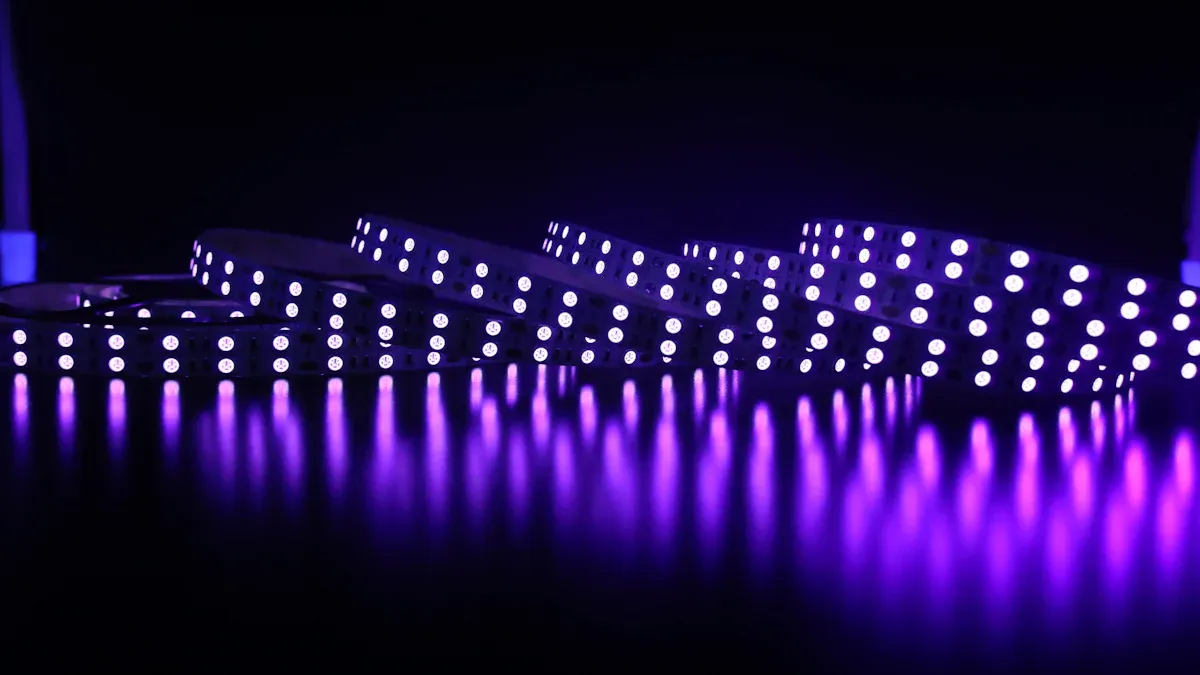
Measuring Lumens
When you pick 12V LED strip lights, knowing lumen output is key. Lumen output shows how bright the strip is. You can measure it as Lumens per Meter. To find the total lumen output, think about the length of the strip you will use. Here are common lumen ranges for different uses:
Accent or Mood Lighting: 100-300 Lumens/ft.
Under Cabinet Lighting: 175-360 Lumens/ft.
Task Lighting: 300-450 Lumens/ft.
Bedroom, Cove Lighting: 180-500 Lumens/ft.
Higher lumen outputs are good for bright lighting needs. For instance, if you want to light up a workspace, choose strips with higher lumens. On the other hand, lower outputs are better for ambient lighting, giving a softer feel.
Choosing Brightness for Your Space
Choosing the right brightness for your space depends on what you do there. Different rooms need different levels of light. The table below shows suggested lumens per foot for different room types:
Room Type | Recommended Lumens/ft. |
|---|---|
Accent or Mood Lighting | 100-300 |
Under Cabinet Lighting | 175-360 |
Task Lighting | 300-450 |
Bedroom, Cove Lighting | 180-500 |
Not enough brightness can make it hard to see. You might struggle to see well, especially when doing tasks. Too much brightness can hurt your eyes and disturb your sleep. This is especially true for blue light from LEDs. Changing the brightness and using warmer colours can help reduce discomfort and improve sleep.
LED strip lights save energy. They turn most of the energy they use into light, not heat. This saves on energy costs while giving you the brightness you need. When choosing the best LED strip lights, think about both brightness and comfort in your space.
Colour Temperature and Options
RGB vs. Single Colour Strips
When you pick between RGB and single colour LED strips, think about how you will use them. Each type has special features for different needs. Here’s a comparison to help you choose:
Feature | Single Colour LED Strips | RGB LED Strips |
|---|---|---|
aplicaciones | Accent lighting, task lighting, ambiance | Mood lighting, decorative displays |
Advantages | Simple, cost-effective, energy-saving | Flexible, control options, creative ideas |
Wiring Configuration | Easy two-pin design | Four-pin design (one for each colour) |
Control Mechanisms | Basic on/off switches or dimmers | Advanced controllers for changing effects |
Brightness Consistency | Steady light in one colour | Changes based on the colour you choose |
Power Consumption | Usually lower energy use | Can use more power with many colours |
If you want different colours and effects, RGB strips are great. For simple uses like task lighting, single colour strips are better.
Understanding Colour Temperature
Colour temperature is very important for the mood and use of your space. It shows how warm or cool the light is, measured in Kelvin (K). Different temperatures create different feelings. Here’s how various colour temperatures change your environment:
Color Temperature | Ambiance and Functionality |
|---|---|
3000K (Warm Light) | Makes a cosy, welcoming feel, great for homes and hotels. |
6000K (Cool Light) | Helps you stay alert and focused, good for work areas. |
For homes, warm white (3000K) is popular for living rooms and bedrooms. Neutral white (4000K) is good for general use, while cool white (6500K) is best for kitchens and bathrooms. Picking the right colour temperature helps you create the right mood and makes your space work better.
Power Consumption of LED Strips
Wattage Considerations
When you choose 12V LED strip lights, wattage is very important. Wattage shows how much power the strips use for each metre. Knowing this helps you figure out the total power needed for your setup.
Here’s a quick look at the usual wattage range for different types of LED strips:
Type of LED Strip | Wattage Range (W/m) |
|---|---|
Monochrome | 4.8 – 12 |
RGB | 14.4 |
To find out the total power use for your LED strip lights, do these steps:
Find out the length of your LED strip lights in metres.
Look at the wattage per metre of the LED strips. This info usually comes from the maker or product details.
Multiply the length of the strip by its wattage per metre to get the total power use.
For example, if you have a 5-metre strip with a wattage of 7W per metre, the total power use would be 35W. This calculation helps you see how much energy your lights will need, so you can plan your electrical needs well.
Energy Efficiency Ratings
Energy efficiency ratings are very important when picking the best LED strip lights. These ratings show how well the lights change electricity into brightness. Higher efficiency means lower energy costs and less harm to the environment.
LED strips usually last for 50,000 to 100,000 hours, which is much longer than other lighting types. For comparison:
Light Technology | Lifespan |
|---|---|
LED | 50,000 to 100,000 hours |
Incandescent | 750 or 1,000 hours |
Fluorescent | 7,000 to 15,000 hours |
The average running cost of LED strip lights is also lower than that of regular lighting options. Here’s a look at the yearly running costs based on three hours of use each day:
Lighting Type | Average Lifespan | Lumens per Watt | Annual Operating Cost |
|---|---|---|---|
Incandescent | 1,000 hours | 10-17 | £8-£12 |
CFL | 8,000 hours | 40-70 | £2-£4 |
Luz de aterrizaje LED | 25,000 hours | 80-100 | £1-£2 |
By choosing energy-efficient LED strips, you not only save money but also help the environment. Always check the energy efficiency rating when picking your lights to make sure you make a smart choice.
Installation of LED Strip Lights
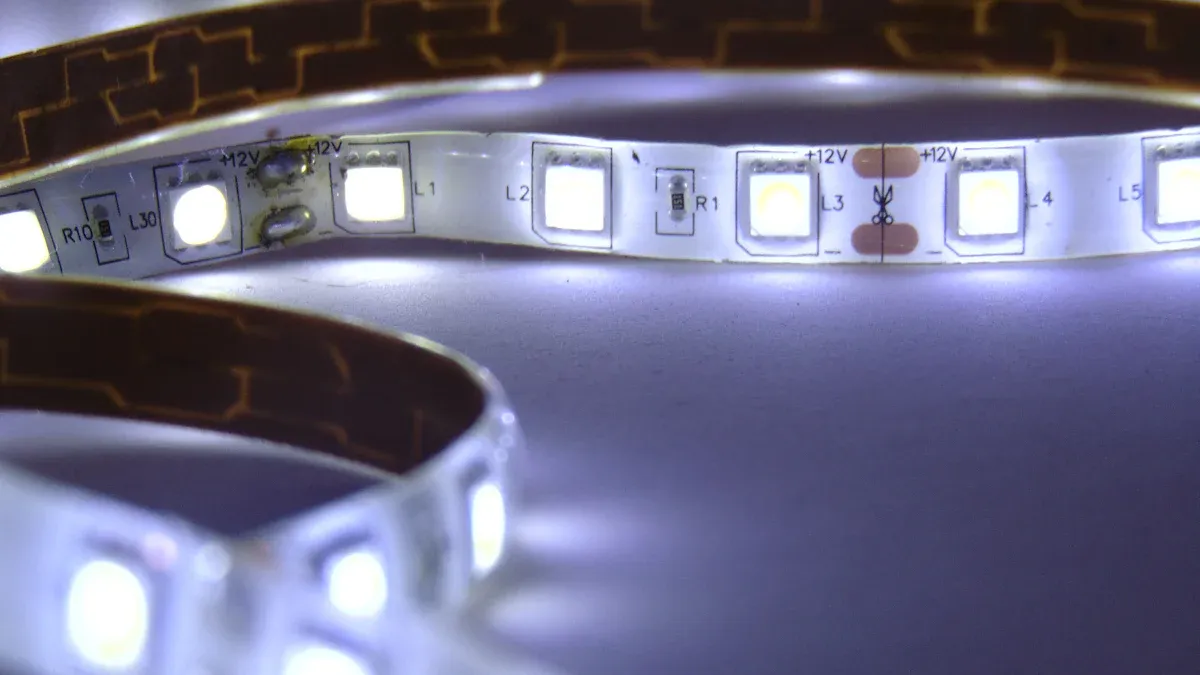
Putting up 12V LED strip lights can really improve your space. To make sure it goes well, think about the right adhesives and ways to mount them.
Adhesives and Mounting Options
When you want to mount your LED strips, there are several good choices. Here are some of the best options:
Extra Adhesive Tape: Use 3M tape to make the bond stronger between the strip and the surface.
LED Strip Mounting Clips: These clips hold the strips firmly in place.
Mounting Track: Aluminium tracks give a neat finish and keep the light strips tidy.
These choices help make sure your strips stay put for a long time, whether at home or in businesses.
Tools for Installation
You will need some tools for a safe and easy installation of your LED strips. Here’s a list of important tools:
LED strip lights
Right power supply (adapter or transformer)
Controller (optional, for colour or remote control)
Double-sided adhesive tape or mounting clips
Mounting channel (recommended)
Installation tools: scissors, wire strippers, screwdriver, and a tape measure for accurate layout
Surface cleaning supplies
For DIY installations, you can keep it simple with basic tools like scissors and tape. But, professional installations might need extra tools for a neat look.
Before you start, make sure to take safety steps. Check that the power source isn’t overloaded to stop overheating. Keep connections dry, as they are not waterproof. Regularly check for wear, damage, or exposed wires to stay safe.
By following these installation tips, you can enjoy the best LED strip lights in your space without any trouble.
Environmental Resistance of LED Strips
When you choose 12V LED strips, think about if you need them for indoors or outdoors. Each type has special features for its setting.
Indoor vs. Outdoor Strips
Outdoor LED strip lights are made with strong materials. They can handle bumps and tough weather.
These strips usually have a higher Ingress Protection (IP) rating. This means they resist dust and water, making them good for bad weather.
Indoor LED strip lights are built more gently. They do not get as much wear and tear as outdoor strips.
Picking the right type helps your lights work well and last longer.
Understanding IP Ratings
IP ratings show how well the lights resist dust and water. This info is important for knowing if LED strip lights are good for different places. Here are some key points about IP ratings:
Different IP ratings mean different levels of protection. This affects how long the lights last.
Choosing the right IP rating for the environment helps ensure good performance and reliability.
The table below shows common IP ratings for 12V LED strip lights:
IP Rating | Protection Level | Suitable Environments |
|---|---|---|
IP20 | Not waterproof | Indoor dry areas |
IP54 | Splash-proof | Indoor areas with minor splashes |
IP65 | Waterproof against splash and short-time immersion | Indoor/outdoor areas with low water exposure |
IP67 | Water immersion | High humidity areas, can be submerged up to 1m |
IP68 | Deep waterproof immersion | Long-term submerged environments, such as deep-sea lighting |
Knowing these ratings helps you pick the best LED strip lights for your needs. Make sure to think about factors like humidity and temperature, as they can change how well the lights work. For example, high humidity can cause moisture problems, while extreme temperatures can make them wear out faster.
By choosing the right LED strips and understanding their IP ratings, you can make your lighting last longer and work better.
Choosing the best LED strip lights needs careful thought about a few things. You should think about brightness, colour choices, power use, how to install them, and how well they resist the environment. Each of these features is important for how happy you will be with the LED strips.
Here’s a quick checklist to help you choose:
Brightness: Make sure it fits your lighting needs.
Colour Options: Pick colours that improve your space.
Power Consumption: Find energy-saving models.
Installation: Think about how easy it is to set up.
Environmental Resistance: Choose strips right for where you want to use them.
Take your time to look at these points. Making a smart choice will give you a better lighting experience.
FAQ
What are the main features of 12V LED strips?
12V LED strips are flexible, save energy, and come in many colours. They give off bright light and can fit in small spaces. You can use them for accent lighting, task lighting, or decoration.
How do I power my 12V LED strips?
To power your 12V LED strips, you need a suitable power supply or transformer. Make sure the power supply matches the total wattage of your strips. This stops overloading and keeps everything safe.
Can I cut my LED strips?
Yes, you can cut LED strips at special points marked on the strip. This lets you change the length to fit your space. Always reconnect the cut ends properly to keep them working.
Are 12V LED strips waterproof?
Some 12V LED strips are waterproof, but some are not. Check the IP rating before you install them. For outdoor use, pick strips with a higher IP rating to make sure they last against water and weather.
How long do 12V LED strips last?
12V LED strips usually last between 50,000 and 100,000 hours. How long they last depends on how you use them and the environment. Good installation and care can help them last longer.
